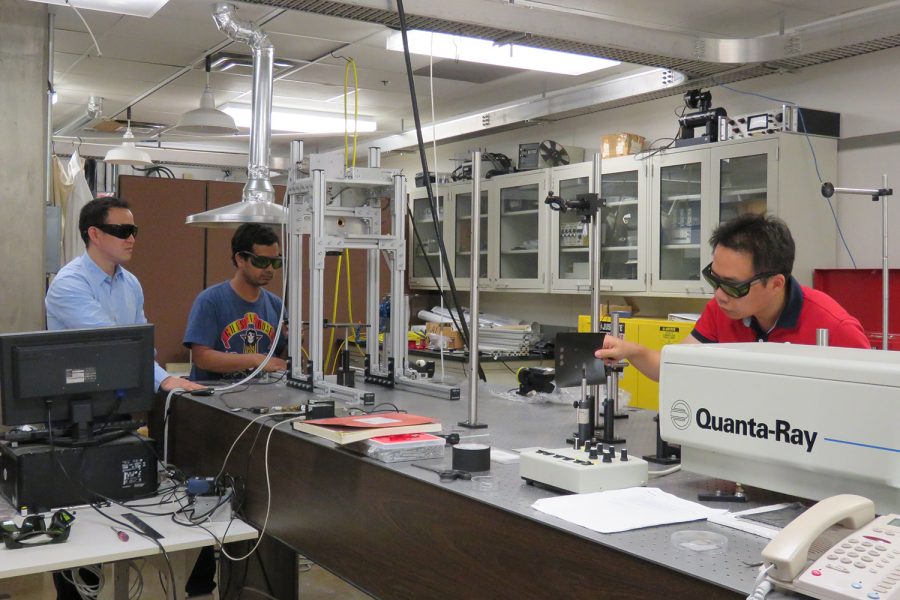UI researchers use simulations to observe how viruses dry on solid surfaces
Two researchers in the University of Iowa College of Engineering received a grant from the National Science Foundation to study how virus droplets that are expelled when someone coughs or sneezes dry on solid surfaces and contribute to the spread of infectious diseases.
Professor Hongtao Ding (left), PhD students Avik Samanta (center) and Qinghua Wang (right) work on a nanosecond laser surface treatment system to conduct experiments in Ding’s laser research lab in the IATL building. (Contributed)
April 29, 2020
University of Iowa researchers recently began a new study to observe through simulations how droplets containing viruses that are ejected when a person coughs or sneezes dry on solid surfaces.
A one-year RAPID grant from the National Science Foundation totaling $200,000 will fund the research. The work will look at multiple viruses such as influenza and different strains of coronavirus.
When a person coughs or sneezes, droplets from their respiratory tract are expelled that could contain viruses, said UI mechanical-engineering Professor H.S. Udaykumar, the principal investigator of the research. The droplets can vary in size and some are small enough they dry in the air, he said, but the larger droplets deposit on surfaces.
Viruses can survive for a varying amount of time on different surfaces, Udaykumar said. On materials such as metal and copper, viruses can die after a couple of hours, he added.
The researchers are trying to discover what determines whether a virus survives or perishes on a surface, Udaykumar said. They will be looking at how seasonal conditions, such as humidity and other temperature changes, affect the viruses.
“This particular aspect of survivability as it relates to drying or droplets is not just particular to COVID-19, it applies to every single virus and bacteria as well,” Udaykumar said.
A broad range of data exists on the survival of viruses on solid surfaces, said UI mechanical-engineering Associate Professor Hongtao Ding, co-researcher on the project. The researchers are trying to develop their own experimental methods to control all of the variables such as surface condition, he said.
RELATED: UI researchers take precautions with study subjects amid COVID-19 concerns
Ding’s primary aspect of the research focuses on experimental science, he said, and will evolve with different surfaces. The researchers will use a laser to change surface treatment and adjust the surface roughness and wetness, Ding said.
The researchers will also control the size of the droplets on each surface, he said. They will monitor the drying process of the droplet to accurately measure the size change. They will also look at the chemical composition of the droplets and will control the concentration of salt, he added, which dissolves the droplets.
“We are in mechanical engineering where we’re not going to put the actual viruses in these droplets, but I think we are interested in seeing how [during] this thermal process the droplets change,” Ding said.
Udaykumar approached UI microbiology and immunology Professor Steven Varga to look at the survivability of the viruses and help measure them on the surfaces.
Because the researchers will alter temperature and surface condition in their experiments, Varga said he will sample the surface and try to quantify how much infectious virus is roaming it.
Understanding how viruses survive on different surfaces is important when it comes to how transmittable they are, Varga said. A common way for respiratory illnesses to spread is through contact with surfaces contaminated when someone sneezes or coughs into their hand and then touches something, he added.
“When somebody sneezes and touches a doorknob or any other surface, the droplet will dry over time,” Varga said. “Then the question is how long does the virus survive and remain infectious.”





















